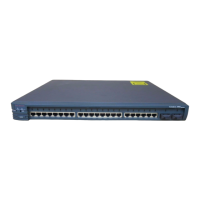Chapter 7
Spanning Tree Protocol (STP)
See the following sections for configuration information about these topics:
■ 7-1: STP Operation: Explains the spanning-tree algorithm in relation to the processes
and decisions made by a switch
■ 7-2: STP Configuration: Presents the basic steps needed to configure the Spanning
Tree Protocol (STP)
■ 7-3: STP Convergence Tuning: Covers the more advanced steps needed to configure
and tune STP convergence
■ 7-4: Navigating the Spanning-Tree Topology: Offers suggestions on how to find the
root of a spanning-tree topology and how to map out an active topology by hand
7-1: STP Operation
■ STP detects and prevents Layer 2 bridging loops from forming. Parallel paths can ex-
ist, but only one is allowed to forward frames.
■ TP is based on the IEEE 802.1D bridge protocol standard.
■ 802.1w is an enhancement to Spanning Tree that provides more rapid convergence
during topology changes than with traditional Spanning Tree.
■ Cisco Switches run one instance of STP per VLAN with PVST+ (per VLAN spanning
tree) or Rapid-PVST+ (Rapid Per VLAN Spanning Tree). Trunking is required
between switches to run RPVST.
■ For industry standard IEEE 802.1Q trunks, only a single instance of STP is required
for all VLANs. The Common Spanning Tree (CST) is communicated over VLAN 1.
■ PVST+ is a Cisco proprietary extension that allows switches to interoperate between
